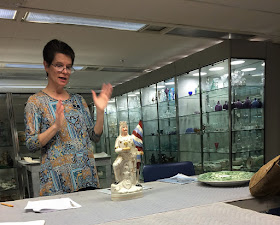 |
Wedgwood Portland Vase pitcher,
nineteenth century |
On April 4-5, 2019, I ventured down the Brandywine Valley to participate as a scholarship recipient in Winterthur Museum’s annual conference
Ceramics Up Close: Hands-On Study Days. Over the course of the program, collectors and visiting scholars like myself took part in hands-on workshops and presentations dedicated to the study of ceramics. The forum’s main speakers included ceramics experts such as the Birmingham Museum of Art’s Chief Curator of Decorative Arts, Anne Forschler-Tarrasch, PhD, who oversees the nation’s largest collection of ceramics ranging from Vietnamese stoneware to Wedgwood pottery. In her presentation, she displayed highlights from the BMA’s Beeson Wedgwood Gallery, including an eighteenth-century jasperware copy of the Portland Vase, which is almost strikingly similar to two mid-nineteenth-century copies in WAM’s collection (1901.7 and 1937.142).
1 The BMA’s ongoing efforts in documenting their Wedgwood collection involve identifying potential fakes through XRF analysis. For instance, one black basalt teapot with caneware design was determined fake due to its rough unglazed interior and large portion of cobalt not found in other Wedgwood stoneware.
2
 |
| Anne Forschler-Tarrasch with Wedgwood pottery |
Amanda Isaac, the Associate Curator of Mount Vernon, discussed George and Martha Washington’s numerous dinner services at Mount Vernon (e.g. Society of the Cincinnati service), explaining how they acted as powerful social currency and agents of sociability in eighteenth-century America.
3 Colonial Williamsburg’s Curator of Ceramics and Glass, Suzanne Hood, highlighted this fact while describing the Foundation’s collection of Chinese export porcelain, as part of her exhibition “China of the Most Fashionable Sort: Chinese Export Porcelain in Colonial America.” During her workshop, she provided pre-1775 examples of export porcelain that were owned and used in Colonial America based on archaeological evidence found in historic sites like Williamsburg. These pieces included serving dishes with lotus decoration and a platter featuring Indian textile patterns, which are inspired by plants like hibiscus and pomegranate native to Southeast Asia.
4 According to Hood, rather than commissioning specific colors and patterns, eighteenth-century consumers concerned themselves with purchasing the most fashionable porcelain brought over from abroad. Finally, Leslie Grigsby, Winterthur’s Senior Curator of Ceramics and Glass, led her workshop on ceramics inspired by literature (e.g.
Aesop’s Fables), ending the conference on a delightful note with her lecture on ceramics celebrating the English monarchy up to King George III’s reign.
 |
| Leslie Grigsby |
Ceramics Study Days at Winterthur was a positive, enriching experience that allowed me to connect intimately with decorative arts professionals and exclusively handle rich collections of ceramics. Most importantly, I learned how ceramics served wide-ranging functions as important commemorative vessels and status symbols that dictated colonial taste and consumption. As Curatorial Assistant at the Worcester Art Museum, I currently work on projects involving the reinstallation of the American art galleries. One of the galleries will feature approximately thirty decorative objects, including Chinese export porcelain, that integrate with the fine arts and explore the cost of luxury in the British colonies. By witnessing some of the finest examples of ceramics during my time at Winterthur, my hope is to utilize the knowledge gained to better educate and foster appreciation for American decorative arts, because objects like ceramics have fascinating histories that can broaden our understanding of early America.
[For more programs and enrichment opportunities at Winterthur Museum, Garden & Library, visit the link
here.]
-Elizabeth Fox, Curatorial Assistant, American Art Department
April 8, 2019
 |
| India textile patterned platter 1770 |
1 In her workshop demonstration, Forschler-Tarrasch presented a nineteenth-century copy of Wedgwood’s Portland Vase in pitcher form, which closely compares in quality to WAM’s copies. Conversely, the BMA’s eighteenth-century Wedgwood Portland Vase is a first-edition copy made of higher quality (hence its softer, lighter blue jasperware with a gray tinge).
2 Various Wedgwood fakes from the twentieth century can be attributed to one Staffordshire potter, J. Palin Thorley, who formerly apprenticed at Wedgwood Factory before immigrating to the U.S. in 1927.
3 The Society of the Cincinnati service was commissioned by Revolutionary War veteran and Society member Samuel Shaw, who brought the service over from Canton (Guangzhou) in 1784.
4 The platter does not show a “tobacco leaf” design, as formerly understood by collectors.




